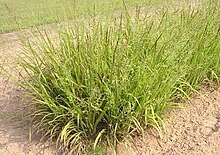
Panicum (panicgrass) is a large genus of about 450 species of grasses native throughout the tropical regions of the world, with a few species extending into the northern temperate zone. They are often large, annual or perennial grasses, growing to 1–3 m tall.

Echinochloa crus-galli is a type of wild grass originating from tropical Asia that was formerly classified as a type of panicum grass. It is commonly known as cockspur, barnyard millet, Japanese millet, water grass, common barnyard grass, or simply "barnyard grass". This plant can grow to 60" in height and has long, flat leaves which are often purplish at the base. Most stems are upright, but some will spread out over the ground. Stems are flattened at the base. The seed heads are a distinctive feature, often purplish, with large millet-like seeds in crowded spikelets.

Tripsacum dactyloides, commonly called eastern gamagrass,or Fakahatchee grass, is a warm-season, sod-forming bunch grass. It is widespread in the Western Hemisphere, native from the eastern United States to northern South America. Its natural habitat is in sunny moist areas, such as along watercourses and in wet prairies. In some areas, it has adapted well to disturbed conditions.

Zeltnera namophila, known by the common name spring-loving centaury, is a rare species of flowering plant in the gentian family. It is endemic to the Amargosa Valley, in Nye County, southwestern Nevada.

Panicum hemitomon is a species of grass known by the common name maidencane. It is native to North America, where it occurs along the southeastern coastline from New Jersey to Texas. It is also present in South America.

Panicum repens is a species of grass known by many common names, including torpedograss, creeping panic, panic rampant, couch panicum, wainaku grass, quack grass, dog-tooth grass, and bullet grass. Its exact native range is obscure. Sources suggest that the grass is native to "Africa and/or Asia", "Europe or Australia", "Eurasia", "Australia", "Europe, Asia, and Africa", or other specific regions, including the Mediterranean, Israel, and Argentina. It is present in many places as an introduced species and often a noxious weed. It has been called "one of the world's worst weeds."

Aeschynomene americana is a species of flowering plant in the family Fabaceae (legume) known by many common names, including shyleaf, forage aeschynomene, American joint vetch, thornless mimosa, bastard sensitive plant (Jamaica), pega pega, pega ropa, antejuela, ronte, cujicillo, and dormilonga. It is native to Central America, parts of South America, the West Indies, and Florida. It is now found in the USA, in Australia and in South-East Asia.

Amphicarpum muehlenbergianum is a species of grass known by the common names blue maidencane, Muhlenberg maidencane, and goobergrass. It is native to the southeastern United States.
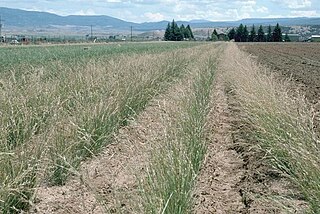
Bromus marginatus is a species of grass known by the common name mountain brome. It is native to western North America, and it is used widely for grazing animals and revegetating landscapes.

Dichanthelium scoparium is a species of grass known by the common names velvet panicum, velvety panicgrass, and broom panicgrass. It is native to North America, where it occurs in the southeastern United States. It also occurs in the West Indies.
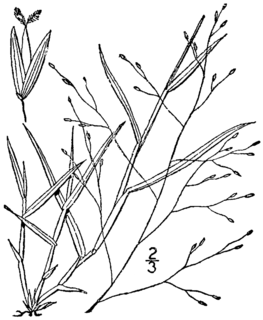
Digitaria cognata is a species of grass known by the common names fall witchgrass, Carolina crabgrass, and mountain hairgrass.
Muhlenbergia lindheimeri is a species of bunch grass, 3-6' H, known by the common names big muhly, blue muhly, and Lindheimer's muhly. It is native to North America, where it can be found in northern Mexico and up to the Edwards Plateau region of Texas. It is also grown as an ornamental grass. as it is useful as a green screen, erosion control, water retention and nest material for many species of birds
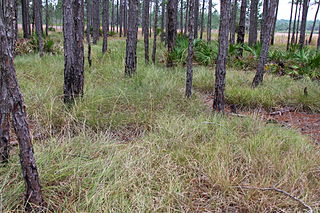
Panicum abscissum is a species of grass known by the common name cutthroat grass. It is endemic to Florida in the United States. It is limited to five counties in the central Florida peninsula.

Panicum amarum is a species of grass known by the common name bitter panicum. It is native to North America, where it is found in coastal regions along the East Coast and Gulf Coast of the United States and into northeastern Mexico. It also occurs in The Bahamas and in Cuba.

Panicum coloratum is a species of grass known by the common names kleingrass, blue panicgrass (USA), white buffalograss ; Bambatsi panic, makarikari grass, and coolah grass (Australia). It is native to Africa, and it has been introduced elsewhere, such as the United States and Australia, and bred into many cultivars.

Paspalum floridanum is a species of grass known by the common name Florida paspalum. It is native to the eastern United States.

Poa fendleriana is a species of grass known by the common name muttongrass. It is native to western North America, where its distribution extends from western Canada to northern Mexico.
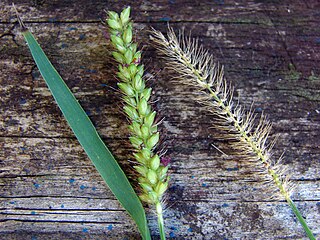
Setaria parviflora is a species of grass known by the common names marsh bristlegrass, knotroot bristle-grass, bristly foxtail and yellow bristlegrass. It is native to North America, including Mexico and the United States from California to the East Coast, Central America and the West Indies, and South America.
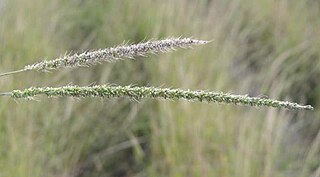
Setaria vulpiseta is a species of grass known by the common name plains bristlegrass. It is native to North America, where it occurs in Texas to Colorado to Arizona in the United States and northern and central Mexico.
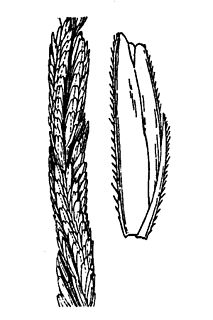
Spartina spartinae is a species of grass known by the common names gulf cordgrass and sacahuista. It is native to the Americas, where it occurs from the Gulf Coast of the United States south to Argentina.
